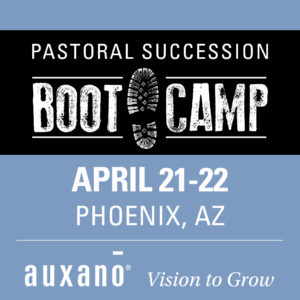In a very real sense, all pastors are INTERIM pastors. At some point you will not hold the current position you find yourself in at your church. It is only temporary. And that means that there is a 100% chance that you or your church will be a part of a succession or transition! – Leadership Network
And according to Lyle Schaller, “The larger the church, the longer the tenure, and the sharper the growth pattern, the more crucial is succession and the more difficult to work it out.”
Change is hard. And leadership succession can implode a church if not handled with extreme care and planning.
Leadership Network tackled the issue of succession in an online conference on January 21 entitled “Succession.”
For over four hours, pastors from churches of all sizes and faith backgrounds talked about the transitions they went through. Some were planned and thought through for years. Others were emergency transitions made necessary due to untimely death or a moral failure.
Here are some of the best quotes from the day:
His decision to pass the torch moved the congregation from uncertainty of the future to anticipation of the future.
Jay Passavant, Founding Pastor, North Way Christian Community
If it’s not successful, it’s not succession.
Jerry Hutchins, Founding Pastor, Kingdom Now Ministries
Five things to consider during your church’s transition:
- Keep your eyes fixed on the Lord of the church.
- Make God supreme in your transition.
- We need to take human sin seriously. We knew we could get this wrong
- We want to serve and love people.
- We needed to believe the Gospel.
Jason Meyer, Pastor for Preaching & Vision, Bethlehem Baptist Church
When I need the church more than the church needs me, I’ve stepped over the line.
Don’t let the applause of people be more important than the applause of God.
Gene Getz, Founding Pastor, Fellowship Bible Church
The biggest surprise for me has been the speed at which God has worked at Eastside. You cannot underestimate the spiritual component in successions.
Gene Appel, Senior Pastor, Eastside Christian Church
I love the church so much that I dare not love you to death.
Jonathan Alexander, Senior Pastor, NorthShore Baptist Church
I can’t do it. But You can. So God… do it today.
Jonathan Falwell, Senior Pastor, Thomas Road Baptist Church
In succession, you have to know the difference between wants and needs. I told the church, this will either fail miserably, or God is going to do greater things here than ever before.
Jason Gerdes, Lead Pastor of Revolution Church
You’re writing a death warrant for yourself if you try to do succession alone.
Three groups of people you’ll find when you step into a church in this situation:
- People that will trust you because you are their pastor. They will be your greatest source of encouragement.
- People who want to trust you, but they’ve been hurt by abusive past leadership. They will trust you over time, but you have to earn their trust.
- People that have been hurt before by church leadership, and the think it will always be the case. They will make your life miserable because there’s nothing you can do to earn their trust.
Succession should look like 4×100 relay. The hand off happens at full speed instead of when you’ve run out of energy.
Brady Boyd, Senior Pastor, New Life Church
Our story is just as much about submission as it is about succession.
Succession planning is good. Succession development is great. Skill sets can be developed that will help with succession, and that’s just as important as the implementation of the ‘plan’.
Jason Bolin, Senior Pastor, Trinity Chapel
Not everyone will be excited that you’re there. Most people will smile, not everyone will be happy. In fact, people will be suspicious of whether or not you’ll be able to fill the shoes of your predecessor.
Jonathan Stockstill, Lead Pastor, Bethany Church
Talk about the vision. Over and over. Talk repeatedly about what you’re doing and why you’re doing it.
Andre’ Butler, Senior Pastor, Word of Faith International Christian Center
If a church is always looking to its past, there is no current compelling vision.
We celebrate five-yard plays, not touchdowns. We strive to honor the past without being held captive to it.
Mike Erre, Senior Pastor, First Evangelical Free Church
Absolute clarity and alignment of the vision is the foundation for our DNA, which is bigger than our leadership at any given time.
Michael LaMonica, Elder, Willow Creek Community Church
Questions You Should Be Asking When Looking Ahead to Succession
- Is Jesus enough for you in YOUR transition?
- What is your relationship with the person who will take over for you? (Or, what is your relationship with the person you’re taking over from?) Mutual respect and admiration, communicated well and often, will be a great asset to your church during transition.
- If you’re getting ready to pass the baton, how well have you ‘positioned’ your church for the future (and the future leader)?
- What could be done by you right now that could give your successor a head start on where God wants to take your church?
- It’s easy to get discouraged when you try to carry the weight of a succession on your own strength. What part of your succession plan do you need to turn over to God?
- What do you think you know that you really don’t know?
- Succession discussions don’t happen in five minutes. Are you allowing your leader the time and space that he/she needs to working through the emotional and spiritual preparation for succession?
- If you’re considering passing the baton in the near future, are you really sure that’s what God wants you to do? Are you sure you’re not just tired and need a nice vacation or extended sabbatical?
There’s really only one remaining question to consider:
Does the church you lead have a succession plan?
For more information on succession from Leadership Network, go here.

Tags: Leadership Network, Leadership Succession, succession planning
|
What is MyVisionRoom? > | Back to Vision >

























